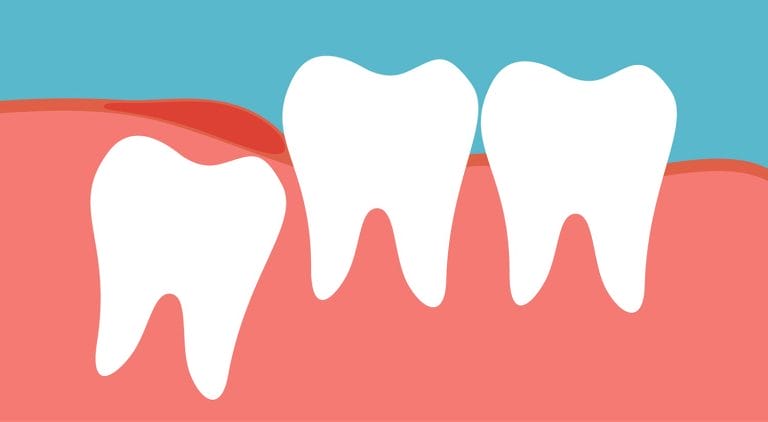Surgery to remove wisdom teeth is standard practice in the United States. In fact, wisdom teeth removal is a rite of passage for many American teens. That said, does everyone need to have their wisdom teeth removed?
Many dentists today recommend extraction, but what if the teeth do not hurt? What if they emerged completely – without incident or pain? If they are not causing problems, is wisdom teeth removal really necessary?
To answer that question, it is important to know something about wisdom teeth. What are they? Where, when, and why do they come in? And what happens next?
What Are Wisdom Teeth?
Wisdom teeth are the third and last set of molars people get. From infancy to adolescence, teeth emerge in stages. First come incisors, then canines followed by premolars and molars. Wisdom teeth emerge last, usually when people are in their late teens or early twenties.
Most people develop four wisdom teeth – one in each quadrant of the upper and lower jaw. This happens between the ages of 17 and 21, according to the American Dental Association.
Some wisdom teeth partly erupt, while others stay buried in the gum tissue. How they emerge differs for everyone. When wisdom teeth that remain in the jaw – covered by tissue or bone – the diagnosis is “impaction.”
Wisdom teeth can cause problems, and they are not needed for chewing. As a result, dentists speculate about their purpose. In early human history, the typical foods were abrasive to teeth. Wisdom teeth may have replaced worn-out molars. Modern diets are softer and teeth do not wear down as fast, so today’s wisdom teeth have no gaps to fill.
Prevention Strategies
Wisdom teeth are notorious for causing pain, infection, tooth decay, gum disease and other complications. When cysts form below the teeth, they can cause bone loss or nerve pressure in the jaw.
Certain actions – such as brushing with a long, slim toothbrush – are prevention measures. They address dental problems before they can start. A doctor may opt to remove healthy molars to prevent future problems.
Even if wisdom teeth do not hurt, it does not mean there is nothing wrong. The jawbone may encase the teeth, or the mouth may be too small for them to erupt in the right position. Teeth that grow at an angle can damage adjacent teeth and make it harder to remove.
People who wait to have their wisdom teeth removed may run into problems after surgery. Heavy bleeding, fractured teeth, numbness and loss of jaw movement are potential problems. These symptoms could last for days or for life.
When Is Removal of Wisdom Teeth Necessary?
When wisdom teeth cause problems – or an Xray shows potential problems – the teeth must come out. A good reason for extraction is damage to other teeth. An extra set of molars can push the other teeth around and cause pain or bite problems.
Jaw damage is another reason to remove wisdom teeth. Permanent damage may occur if cysts form around the new teeth. Untreated, they can hollow out the jaw or damage nerves in the area.
Sometimes, wisdom teeth cause sinus issues. Common signs are pain, pressure or sinus congestion. These conditions may make it necessary to remove the teeth.
Inflamed gums and cavities are two more signs that may call for teeth removal. Inflammation causes gum tissue to swell, making it hard to clean the teeth. Swollen gums may also create pockets between teeth that are magnets for bacteria.
Food and debris can get trapped in these pockets, encouraging bacteria to grow. This can cause dental cavities that are hard to fill or crown. Extraction may be the only option.
Tooth alignment is a another consideration. When teeth remain in the gum tissue or grow in crooked, crowding can occur. Some cases may even need treatment to straighten other teeth.
What Can Patients Expect When Removing Wisdom Teeth?
A dentist looks at the shape of the mouth and position of the teeth to make a decision about wisdom teeth. What are signs, symptoms and conditions are at play? Age and general health have a role, too.
Most people have wisdom teeth surgery when they are teens or young adults. Yet, older adults can also have the procedure. It all depends on the diagnosis – or prevention.
Wisdom teeth first show up on X-rays when people are in their mi-teens. The teeth are easy to feel as they push against the back gums. Sometimes they cause unbearable symptoms: pain, swelling, sore jaw, cavities and gum disease.
When teeth must come out, it is usually due to partial eruption, infection or overcrowding. For most people, extraction is a short and painless procedure. A special dentist called an oral surgeon removes the teeth in a dental office.
The surgery takes less than 45 minutes. Sometimes, sedation is needed. The doctor will use one of three types of anesthesia: local, general, or IV sedation. Depending on the type, a patient may feel drowsy after surgery – but no pain at all during the procedure.
If the surgeon must cut the gums or bone to remove the teeth, and he will close the wound with stitches. Then, he will place gauze pads in the mouth to absorb the blood and encourage clotting.
The mouth usually heals in a few days, and people can go back to work or school the next day. Some people drive themselves to and from the dental office. If the surgery involved general anesthesia or pain medication, another adult must drive.
Most people have very little pain after wisdom teeth removal. To reduce swelling and fight infection, doctors recommend using an ice pack on the first day. After that, moist heat can relax a sore jaw.
For a few days after surgery, people should eat soft foods and drink plenty of fluids. They should not drink through a straw, as sucking can loosen the blood clots that help the mouth heal. Smoking is also a no-go as it can also slow healing.
Doctors encourage gentle brushing of the teeth on the day after surgery – taking care not to dislodge a clot. Gentle saltwater rinses after the first day soothe the mouth and promote healing.
Pain and Complications Associated with Wisdom Teeth Removal
Some people receive antibiotics to help prevent infection. A doctor may prescribe medication to relieve pain and swelling. For most people, over-the-counter medicine is effective for pain relief. Patients should call the doctor if they have a fever, or if pain or swelling does not improve.
Complications are rare, but when one occurs, it is likely dry socket. This is when the blood clot that formed in the tooth socket breaks down or is dislodged. Less than five percent of people develop dry socket, and a dentist can address it. With rest and proper care, it should heal in a week or so.
Searching for a Gentle Dentist on Long Island or in the Port Washington Area?
It can be hard to decide if wisdom teeth removal is necessary. Without the typical signs and symptoms, such as pain, surgery may seem pointless. But sometimes, prevention is the best strategy. Contact our dental clinic and gentle dental team. Together, we can find the right treatment for your wisdom teeth.



